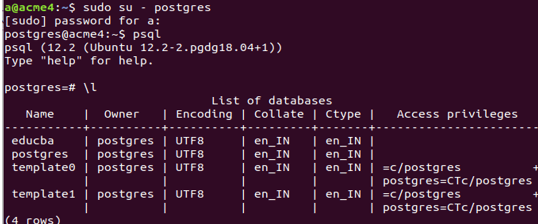

Reliability: PostgreSQL provides a reliable environment with special features such as multi-version concurrency control (MVCC), point-in-time recovery, tablespaces, asynchronous replication, online/hot backups, and write-ahead logging.ĭid you know that 75-90% of data sources you will ever need to build pipelines for are already available off-the-shelf with no-code data pipeline platforms like Hevo?Īmbitious data engineers who want to stay relevant for the future automate repetitive ELT work and save more than 50% of their time that would otherwise be spent on maintaining pipelines.It also provides a robust access control system along with column & row-level security. It provides different authentications such as Lightweight Directory Access Protocol (LDAP), Generic Security Service Application Program Interface (GSSAPI), SCRAM-SHA-256, Security Support Provider Interface (SSPI), etc. Data Security: You can rest assured with several layers of data authentication and protection layers.It is compatible with several data types such as INTEGER, NUMERIC, BOOLEAN, CHAR, VARCHAR, DATE, INTERVAL, and TIMESTAMP, etc.

#POSTGRES COPY TABLE TRIAL#
Get your free trial right away! Key Features of PostgreSQL Solve your data replication problems with Hevo’s reliable, no-code, automated pipelines with 150+ connectors. It also supports a wide range of popular programming languages such as Python Java, C#, C, C++, Ruby, JavaScript, (Node.js), Perl, Go & Tcl. It acts as a robust back-end database that powers many dynamic websites and web applications. PostgreSQL is an integral part of the Modern LAPP Stack that consists of Linux, Apache, PostgreSQL, and PHP (or Python and Perl). Owing to its flexibility & scalability, PostgreSQL serves as a primary data store or Data Warehouse for many web, mobile, geospatial, and analytics applications. Introduced on July 8, 1996, PostgreSQL is a direct successor to the Ignes database. PostgreSQL is an Open-source Relational Database Management System (RDBMS) that fully supports both SQL (Relational) and JSON (Non-relational) querying. In addition, there is a third method that offers a simpler alternative, which involves using Hevo Data to seamlessly replicate your data into your PostgreSQL destination.
#POSTGRES COPY TABLE HOW TO#
The first two methods cover how to import CSV file in PostgreSQL using the COPY command and pgAdmin to import CSV files into PostgreSQL. In this article, you will learn how to effectively perform the PostgreSQL import CSV operation using 3 different methods. One of the primary jobs is to import CSV to PostgreSQL to add data to your PostgreSQL tables.

Method 3: Perform PostgreSQL Import CSV Job using HevoĬSV(comma-separated values) is a common format used for storing millions of records for a business.Method 2: Perform PostgreSQL Import CSV Job using pgAdmin.Method 1: Perform PostgreSQL Import CSV Job using the COPY Command.


 0 kommentar(er)
0 kommentar(er)
